BRIANNA ACADEMICS
NURSING
- 262
- 0
- 3
Community
- Followers
- Following
8 Reviews received
265 items
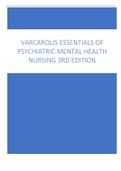
VARCAROLIS ESSENTIALS OF PSYCHIATRIC MENTAL HEALTH NURSING 3RD EDITION
VARCAROLIS ESSENTIALS OF PSYCHIATRIC MENTAL HEALTH NURSING 3RD EDITION
- Exam (elaborations)
- • 332 pages •
VARCAROLIS ESSENTIALS OF PSYCHIATRIC MENTAL HEALTH NURSING 3RD EDITION

WEBER-HEALTH ASSESSMENT IN NURSING 6TH EDITION TEST BANK
WEBER-HEALTH ASSESSMENT IN NURSING 6TH EDITION TEST BANK
- Exam (elaborations)
- • 349 pages •
WEBER-HEALTH ASSESSMENT IN NURSING 6TH EDITION TEST BANK
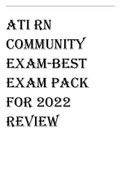
ATI RN COMMUNITY HEALTH 2022
ATI RN COMMUNITY HEALTH 2022
- Exam (elaborations)
- • 26 pages •
ATI RN COMMUNITY HEALTH 2022
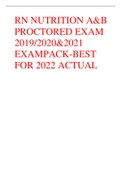
RN NUTRITION A&B PROCTORED EXAM 2019/2020&2021 EXAMPACK-BEST FOR 2022 ACTUAL
RN NUTRITION A&B PROCTORED EXAM 2019/2020&2021 EXAMPACK-BEST FOR 2022 ACTUAL
- Exam (elaborations)
- • 73 pages •
RN NUTRITION A&B PROCTORED EXAM 2019/2020&2021 EXAMPACK-BEST FOR 2022 ACTUAL

ATI RN COMPREHENSIVE PREDICTOR EXAM PACK-2022 BEST FOR ACTUAL EXAM REVIEW
ATI RN COMPREHENSIVE PREDICTOR EXAM PACK-2022 BEST FOR ACTUAL EXAM REVIEWATI RN COMPREHENSIVE PREDICTOR EXAM PACK-BEST FOR 2022 REVIEW A nurse is caring for a client who is experiencing a diazepam overdose. Which of the following medication should the nurse administer? Flumazenil A nurse is caring for a client who is febrile. To reduce the client’s fever, the nurse applies a cooling blanket. Which of the following findings indicates the client is having an adverse reaction to the...
- Exam (elaborations)
- • 102 pages •
ATI RN COMPREHENSIVE PREDICTOR EXAM PACK-2022 BEST FOR ACTUAL EXAM REVIEWATI RN COMPREHENSIVE PREDICTOR EXAM PACK-BEST FOR 2022 REVIEW A nurse is caring for a client who is experiencing a diazepam overdose. Which of the following medication should the nurse administer? Flumazenil A nurse is caring for a client who is febrile. To reduce the client’s fever, the nurse applies a cooling blanket. Which of the following findings indicates the client is having an adverse reaction to the...
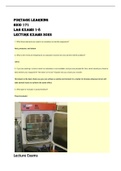
Portage Learning BIOD 171 Lab Exams 1-8 Lecture Exams 2022
Portage Learning BIOD 171 Lab Exams 1-8 Lecture Exams 2022 Lecture Exams 1. What three elements are used in an autoclave to sterilize equipment? heat, pressure, and steam 2. What is the minimum temperature an autoclave must be set at to achieve sterile condition? 125°C 3. If you are working in a lab in which an autoclave is not available, and you are pressed for time, which would you chose to best sterilize your equipment? Hot steam or hot air? Explain why you chose your answer. ...
- Exam (elaborations)
- • 19 pages •
Portage Learning BIOD 171 Lab Exams 1-8 Lecture Exams 2022 Lecture Exams 1. What three elements are used in an autoclave to sterilize equipment? heat, pressure, and steam 2. What is the minimum temperature an autoclave must be set at to achieve sterile condition? 125°C 3. If you are working in a lab in which an autoclave is not available, and you are pressed for time, which would you chose to best sterilize your equipment? Hot steam or hot air? Explain why you chose your answer. ...
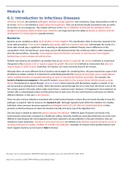
NURS 251 Module 6 Portage learning
NURS 251 Module 6 Portage learning Module 6 6.1: Introduction to Infectious Diseases Infectious diseases are caused by pathogenic (disease-causing) organisms such as bacteria, fungi, and parasites as well as by viruses. Bacteria are defined as single-celled microorganisms. They can be found virtually everywhere and can either be harmless or very dangerous. This module will focus on the role of antibiotics to eliminate the pathogenic effects brought on by bacteria within a human host. Ant...
- Exam (elaborations)
- • 9 pages •
NURS 251 Module 6 Portage learning Module 6 6.1: Introduction to Infectious Diseases Infectious diseases are caused by pathogenic (disease-causing) organisms such as bacteria, fungi, and parasites as well as by viruses. Bacteria are defined as single-celled microorganisms. They can be found virtually everywhere and can either be harmless or very dangerous. This module will focus on the role of antibiotics to eliminate the pathogenic effects brought on by bacteria within a human host. Ant...

NURS 251 Module 5 Portage Learning
NURS 251 Module 5 Portage Learning Module 5 5.1: Introduction to Pulmonology The main function of the respiratory system is two-fold: (1) to deliver oxygen to the cells of the body and (2) remove carbon dioxide from the body. This is accomplished through the combination of the upper respiratory tract working in communication with the lower respiratory tract. A diagram of the anatomy of the respiratory tract is shown in Figure 5.1. The upper respiratory tract (URT) is outside the chest ca...
- Exam (elaborations)
- • 8 pages •
NURS 251 Module 5 Portage Learning Module 5 5.1: Introduction to Pulmonology The main function of the respiratory system is two-fold: (1) to deliver oxygen to the cells of the body and (2) remove carbon dioxide from the body. This is accomplished through the combination of the upper respiratory tract working in communication with the lower respiratory tract. A diagram of the anatomy of the respiratory tract is shown in Figure 5.1. The upper respiratory tract (URT) is outside the chest ca...
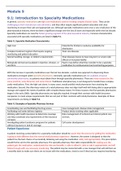
NURS 251 Module 9 Portage Learning
NURS 251 Module 9 Portage Learning Module 9 9.1: Introduction to Specialty Medications In general, specialty medications are high cost medications used for treating complex disease states. They can be challenging to both manufacture and administer, and they often require significant patient education and close monitoring to ensure their safe and appropriate use. Although specialty medications were once a very small piece of the pharmaceutical industry, there has been a significant chang...
- Exam (elaborations)
- • 11 pages •
NURS 251 Module 9 Portage Learning Module 9 9.1: Introduction to Specialty Medications In general, specialty medications are high cost medications used for treating complex disease states. They can be challenging to both manufacture and administer, and they often require significant patient education and close monitoring to ensure their safe and appropriate use. Although specialty medications were once a very small piece of the pharmaceutical industry, there has been a significant chang...
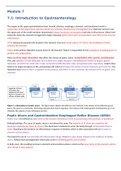
NURS 251 Module 7 Portage Learning
NURS 251 Module 7 Portage Learning Module 7 7.1: Introduction to Gastroenterology The organs of the upper gastrointestinal tract (mouth, pharynx, esophagus, stomach, and duodenum) work in conjunction to first digest food and then absorb the nutrients obtained from the digested food. Both the stomach and the upper part of the small intestines (duodenum) release hormones and enzymes that help in this process. When food enters the body, the stomach is triggered to begin releasing gastric j...
- Exam (elaborations)
- • 13 pages •
NURS 251 Module 7 Portage Learning Module 7 7.1: Introduction to Gastroenterology The organs of the upper gastrointestinal tract (mouth, pharynx, esophagus, stomach, and duodenum) work in conjunction to first digest food and then absorb the nutrients obtained from the digested food. Both the stomach and the upper part of the small intestines (duodenum) release hormones and enzymes that help in this process. When food enters the body, the stomach is triggered to begin releasing gastric j...

CCEA Government and Politics Assessment Unit AS 2 The British Political Process
DEWIT’S MEDICAL SURGICAL NURSING CONCEPTS AND PRACTICE 4TH EDITION STROMBERG TEST BANK 2022
[Question Paper: Pearson Edexcel A-Level 2022] Politics Paper 3: Comparative Politics – Global Politics
DEWIT’S MEDICAL SURGICAL NURSING CONCEPTS AND PRACTICE 4TH EDITION STROMBERG TEST BANK 2022
Questions&Answers ALS FINAL EXAM 2022